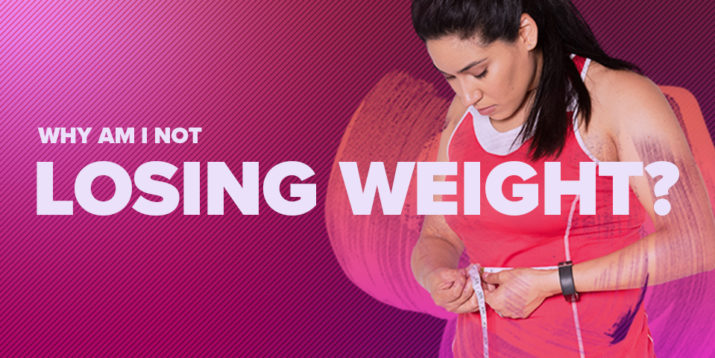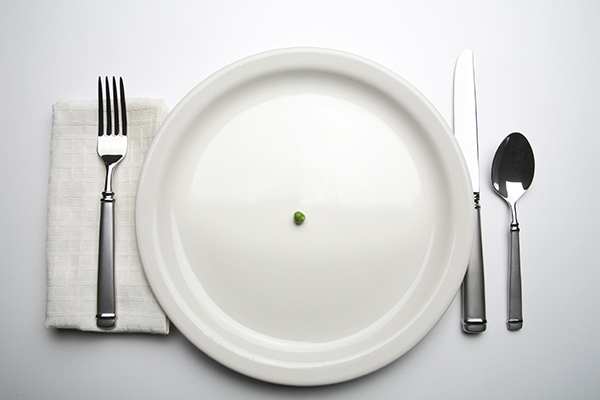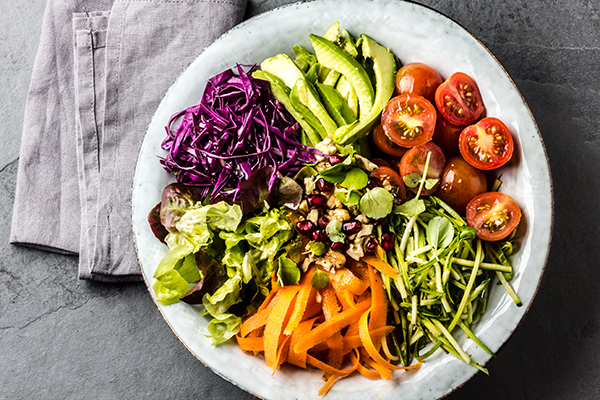Why Am I Not Losing Weight?

In theory, weight loss should be easy: Eat healthy, exercise, and reap the rewards. Easy peasy, right?
But losing weight isn’t always that simple.
You can feel like you’re doing all the right things — and you might lose some weight at first, but then you might reach the dreaded weight-loss plateau.
I’m sure you’ve been there: You’ve followed your diet to a T, you’ve cut calories, you work out regularly, and you’re still not losing weight.
When you’re putting in the work and still not dropping pounds, well, that’s mind-numbingly infuriating.
Unfortunately, it’s not uncommon. But whatever you do, don’t give up.
Below you’ll find 10 reasons why the number on the scale might be stuck, as well as some suggestions on how to help you start losing weight again.
And remember: It’s a journey.
Even before you reach your goal weight by committing to a healthy lifestyle, you’ll start feeling stronger and learning to fuel your body with the right foods, and you might even find a workout you love.
10 Reasons You Might Be Struggling to Lose Weight
Losing weight takes work, but the rewards are worth it: a healthier heart, more energy, and checking yourself out in the mirror (and liking what you see), just to name a few.
1. You Have Unrealistic Weight-Loss Expectations
To be successful with losing weight, you have to have realistic and healthy expectations. And patience!
You didn’t put on all the extra weight in a week or month, and you aren’t going to lose it all in a week or month either. And that’s OK.
Also, you might find that you are not actually losing weight but your body composition is changing, so the number on the scale might not be going down as fast as you like.
Most scales don’t accurately reflect how much water you have in your system, how much body fat you’ve lost, or how much muscle you’ve gained.
That’s why we encourage you to take “before” and “after” photos and to take your measurements.
When you lose body fat, you’ll be able to see it in how your clothes fit and in your pictures. Take a look at these “before” and “after” results to see what we mean!
“Often, I see clients get impatient and, if they don’t lose weight almost immediately, they change their regimens,” says Wesley Delbridge, R.D., a spokesperson for the Academy of Nutrition and Dietetics. “However, they may have been on the right path to begin with; they just needed to give it more time.”
2. You Don’t Eat Enough Food

Super low-calorie and elimination diets — like those that are probably clogging up your social media feed right now — ignore the fact that food is fuel.
Calories, including often-maligned carbohydrates and fat, are required for you to live and breathe.
“Because our body weight is regulated by multiple systems, starving ourselves activates the body’s protective mechanisms to defend our body’s weight,” says Ethan Lazarus, M.D., a board member of the Obesity Medicine Association.
“One of these mechanisms is dropping the metabolism as low as possible. In general, we recommend, unless under medical supervision, not keeping your calories below 1,200 calories per day,” he adds.
3. You’re Not Eating Carbohydrates (or Protein or Fat)

For a healthy diet — whether or not you’re trying to lose weight — the calories you eat should come from a combination of healthy carbohydrates, proteins, and fats, explains San Diego bariatric surgeon Julie Ellner, M.D.
Whole-food sources of unrefined carbs (ex. legumes, fruit, and raw veggies) are vital to keeping energy levels up so that you can crush your workouts.
The fiber found in these carbohydrates (versus, say, a croissant), will help you stay full and help you be less likely to snack on something unhealthy.
In addition, when you eat too few carbs, your body doesn’t stock as much glycogen, the stored form of your body’s primary fuel source, glucose.
And since each gram of glycogen is stored with three grams of water, the scale will reflect that reduction in water weight.
But that’s all it is: water weight. So, while the lower number might be encouraging, it doesn’t reflect your progress toward your ultimate goal: fat loss.
In addition to losing primarily water weight, cutting back too far on carbs can leave you chronically low on energy, which can hamper your weight-loss efforts by keeping you more sedentary and lowering your workout performance.
You also need protein and fat.
Both will help you feel full, but fat also helps regulate your hormones and protein is vital to building lean muscle mass, the primary determinant factor of your metabolic rate, Ellner says.
The more muscle you have, the faster your metabolism will be.
4. You’re Not Working Out Hard Enough

When you go for a jog or long, slow bike ride, you burn calories, but your metabolism settles back to normal soon afterward.
That’s one of the reasons high-intensity exercise — like the kind of metabolic conditioning you’ll find in Beachbody programs such as 9 Week Control Freak and Morning Meltdown 100 — is superior for weight loss.
Not only do you burn more calories during every minute you work out, but your metabolism also remains elevated for days instead of hours.
Another advantage of high-intensity workouts? They can curb your appetite.
A recent study in the International Journal of Obesity looked at sedentary, overweight men who either worked out at a moderate pace for 30 minutes or did high-intensity interval training (HIIT) for the same amount of time.
5. You Only Do Cardio Workouts
When most people want to lose weight, the first thing they turn to is the treadmill, aka, the “dreadmill.”
Hating your workout isn’t going to help you stick with a workout routine. And you may find you have better luck losing weight if you take the emphasis off steady-state cardio and focus more on strength training.
According to one large-scale study from the Harvard School of Public Health, people who spent 20 minutes per day strength training gained less belly fat over the course of 12 years compared to those who logged the same number of minutes doing cardio.
“Even if following a healthy diet for weight loss with adequate protein, we don’t lose 100 percent fat,” says Lazarus. “We lose part body fat and part lean body weight (muscle), and losses in lean body weight can result in the metabolism slowing.”
“Strength training — whether it’s with weights, yoga, Pilates, or any other resistance-based workout — is important to preserve lean body weight and metabolism. Think about it: Weight training gives your body a bigger engine. That bigger engine burns more gas getting you around town,” Lazarus explains.
Cardio can certainly be a part of your weight-loss routine, but try to include weight-lifting sessions and bodyweight circuits into your routine several times per week.
6. You’re Trying to Change Your Whole Lifestyle At Once
Going on a diet sounds like it’s just one simple change.
But in reality, following a healthy diet and weight-loss plan may include shopping for new foods, learning new recipes, changing how you spend your time after work, potentially getting up earlier to work out, increasing your step count, fighting cravings for junk food, drinking more water, and so much more.
That’s a lot to take on at once and can leave you feeling overwhelmed.
That’s why a habit-based approach can help, especially for those who have a history of going on and off diets.
A review from experts at the University College London’s Health Behaviour Research Centre shows that habit formation is vital to making sustainable, long-lasting changes.
Try focusing on changing one thing at a time, and practicing that change until it’s really cemented, and then work on adding in the next one.
Some good examples of healthy changes:
- Aim to eat vegetables in at least two meals each day
- Up the intensity of your workout program
- Cut soda (yes, even diet soda) from your diet
- Read nutrition labels
- Drink enough water
- Take the stairs instead of the elevator
- Add a 15-minute walk after lunch or dinner
- Eat at least one meal a day without distractions
7. You Don’t Pay Attention to Your Body’s Cues

Trying to belong to the clean-plate club can hinder your weight-loss efforts because it ignores your body’s way of regulating food intake: namely, hunger and satiety.
“Paying attention to how each bite makes the body feel is critical to getting in touch with how much food we actually need, as well as what types of foods make us feel good and energized versus fatigued,” Ellner says.
She recommends eating when you are slightly hungry and to stop eating when you are slightly full.
Although a 2014 Public Health Nutrition review suggests intuitive eating is a better tactic for weight maintenance versus weight loss, it has been shown to improve mental health and physical health factors other than body mass index.
If you find yourself gravitating to the kitchen or your desk’s snack drawer, ask yourself, “Am I really hungry?” Often we eat out of habit, boredom, and stress. (Or because we’ve confused hunger with thirst!)
As you eat, nixing distractions such as the TV, computer, and phone can really help you hone in and recognize when you’ve eaten just enough, Ellner says.
8. You Eat More Than You Think You Do
“When people track their food intake for the first time, they are usually shocked to see what they are really eating throughout the day,” says board-certified family and bariatric physician Spencer Nadolsky, D.O., a diplomate of the American Board of Obesity Medicine.
You don’t have to do it forever, but tracking every single thing you eat for as little as a week can help raise awareness of what you are eating and where you are getting excess calories or sugar, Nadolsky says.
Make sure to track everything — those little taste-test bites you take while cooking or handfuls of candy from your coworker’s desk add up.
Plus, if you add a “notes” column to your tracker or food journal, writing down how you felt prior to each meal can help you learn how your emotions, energy levels, and food schedule play into what you eat.
For instance, if you write: “I worked through lunch, and then my blood sugar completely crashed and I felt super shaky” after your “candy bar” entry, that gives you a lot more information as to what will help you avoid that daily 2 p.m. vending machine run, says Delbridge.
Also, don’t try to accelerate your losses by slashing more calories than what’s recommended.
If you don’t eat enough, your body will try to compensate for the excessive calorie deficit by slowing your metabolism. Your goal is to eat at just enough of a deficit to allow your body to burn through its fat stores.
9. You Don’t Get Enough Good Sleep
Just because you can “power through” on not much sleep, it doesn’t mean you can thrive that way — especially when it comes to weight loss.
“When we sleep, body fat makes two important hormones, leptin and adiponectin,” says Lazarus. “Leptin is our body’s best natural appetite-suppressing hormone, while adiponectin is helpful in making our body respond better to insulin.”
He explains, “After inadequate sleep, in addition to being tired, which we all know is every dieter’s worst enemy, we will be hungry and crave carbohydrates.”
In addition, one small study found that when dieters slept for only 5½ hours, they experienced 55% less weight loss and also saw their lean body mass decrease compared with those in the study who got 8½ hours of sleep.
The National Sleep Foundation recommends that adults ages 18 to 64 sleep 7 to 9 hours per night.
If you consistently get less than that — and 35 percent of American adults don’t get this amount, according to the U.S. Centers for Disease Control and Prevention — it’s time to make sleep a priority.
Stop treating sleep as a negotiable or the first thing to go when things get busy.
To set yourself up for success, plan your sleep (establish a regular sleep schedule), and then schedule everything else on your to-do list around it.
10. You Spend a Lot of Time Sitting or Inactive
Hitting your workouts is great, but for optimal results, you shouldn’t limit movement to your workouts, says Nadolsky, noting that it’s your total amount of daily activity that truly matters for weight loss.
Unfortunately, simply exercising for 30 or 60 minutes a day doesn’t move you out of the sedentary category, and research published in the International Journal of Behavioral Nutrition and Physical Activity shows that regular exercisers tend to spend just as much time sitting compared to those who skip their workouts.
Try integrating what Nadolsky calls “exercise snacks” throughout the day. Once per hour, get up and walk around your office, perform a single set of (bodyweight) squats, or just enjoy a few standing stretches.
Take a walking meeting, ditch the escalator for the stairs, or use a basket rather than a shopping cart when picking up a couple of things at the supermarket.
